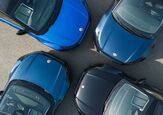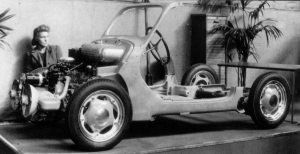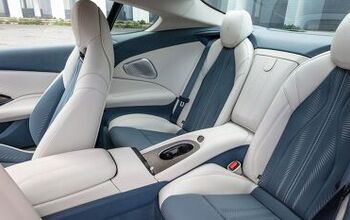An Illustrated History Of Panhard

To many today, the French automaker Panhard (pronounced panAR) may be unknown or rapidly slipping into obscurity. But the story of this once renowned firm, one of the very earliest pioneers of the automobile is remarkable and more relevant than ever. It developed a distinguished series of ultra-efficient two-cylinder cars in the post war era that culminated in this tasty 24TC of 1967, the very last Panhard. It reflected the French approach to automobile making perfectly: innovative, eccentric, stylish, and all to often, out of the mainstream and financial success. But Panhard’s efforts were always highly memorable, advanced, and foreshadowed the cars of today and the future. Before long, we may all be driving updated versions of small, ultra-light and super-efficient 850 cc two-cylinder cars like this. And if this delightful and sporty coupe is anything to go by, it may be something to actually look forward too.
Panhard et Levassor was established in 1887, and built its first car in 1891 based on a license of the Daimler patent. But instead of the rear engine that the first Daimler and Benz cars used, Panhard placed the engine and radiator at the front, with rear driven wheels, and a crude sliding-gear transmission. As such, it was the first FR (front engine – rear wheel drive) car, and that configuration became known as the “Systeme Panhard”. That configuration was later adopted by both Benz and Daimler and is still going strong. And the well-known Panhard Rod or track bar was commonly used on live rear axles .
Panhard became a modest sized builder of mid to upscale technically conventional cars primarily for the domestic French market. Much of their output during the period up to WW II was not particularly memorable, but the very beautiful Dynamic of 1935 certainly was. It reflected the popular aerodynamic influence of the time, and is analogous to the Chrysler Airflow of the same vintage.
But after WWII, Panhard decided to completely re-invented itself, abandoning the upper-middle class cars and developing an ultra lightweight low cost car for the post-war era when automobiles were expected to become available to all. It was a similar line of thinking as that at Citroen, which conceived its solution to the problem with its iconic 2CV.
Panhard put itself to a more ambitious and slightly more upscale task, taking on the development of a concept by AFG (Gregoire) a radical aluminum-bodied FWD compact sedan with an air-cooled boxer twin driving the front wheels. This unusual car even used aluminum in the main frame members (see above two photos). It was an exercise in exploring the outer limits of weight reduction in the pursuit of an optimum ratio of performance to efficiency, and Panhard took on the challenges of making it a production vehicle, the most advanced of its field.
The final result was the 1946 Dyna X, roomy enough four four in comfort, but with decent performance from its tiny but highly economical 600cc boxer twin. But its main competitor, the rear-engined but otherwise more conventional Renault 4CV outsold it by huge margins, and Panhard was challenged to carve out a niche in the increasingly crowded market, especially given the high cost of aluminum.
The little twin’s engine size began a series of incremental increases up to 850 cc, and combined with the car’s remarkable light weight, the Dyna X began to be seen more as a car with sporting potential. It became a popular entry in competitive touring events, and more serious sporty offshoots were inevitable. One could say it took a somewhat similar trajectory as the Corvair: intended to be a low-cost economy family sedan, but finally finding its true mission in enthusiast circles.
By 1952, Panhard embraced its sporty aspect fully, and the goofy little Junior was put into production (See Dyna Junior CC). Think of it as the French Austin Healey Sprite, but with a wide bench seat to accommodate a cozy threesome. That’s much more in the French spirit than those unromantic English bucket seats.
In 1954, the new Dyane Z replaced the X. It had a substantially roomier body, but still kept the basic layout, components and even the aluminum construction. That didn’t last, though, and within a few years, steel began to replace the more expensive large aluminum pieces. But the Dyna remained a remarkably light , roomy and efficient car nevertheless.
In fact, the wider Dyna Z was considered a six-passenger car (even a stretch in that time of sleek bodies), and its front compartment shows the tasteful and tidy design to maximize interior space. Note the well padded and smooth dashboard, an early concession to safety. And its more conventional four-on-the-tree stick shift, unlike the earlier umbrella handle shifter of the earlier models. In 1955, Citroen bought a 25% stake in Panhard, opening up the a much larger dealer network, and leading to the eventual complete takeover in the early sixties.
This vintage ad highlights the Dyna’s key features: 130 kmh (80 mph) top cruising speed, 7 liters/100kmh fuel consumption (34 mpg), and room for six! I’m not going to try to convert the price. The Dyna Z was simply unparalleled in its abilities to deliver these numbers in its time. One is readily tempted to call it the Prius of its time, although in looks it reminds me slightly more of the first Taurus.
The Firm of Deutsch Bonnet (DB) built a series of sports racers based on the Dyna that were phenomenally successful, especially in the long distance races like Le Mans and Sebring, where an Index of Performance (based on engine size) played perfectly to the Panhard formula. Their reliability and surprising speed allowed them to often score in the top ten, even against the big Jaguars and Ferraris of the day.
The DB panhard success story went on for years, and finally culminated in its most extreme manifestations in 1964.
Here are the 1964 Le Mans prototype CD Panhard and its production variant, the fastest of the street Panhards. (A full brochure is here). The street model had Panhard’s “Tigre” engine that developed 60 hp from 850 cc, quite an accomplishment for the times, more than double of typical “sporty” cars of the times in terms of hp/liter. Top speed was over 110 mph. The Le Mans prototype was the first to feature a “long tail” and other aerodynamic aids. Top speed was some 140 mph. These are incomparable cars of their times, despite all the attention that the big-engined Ferarris and Ford GTs receive.
In 1960, the aging Dyna received a questionable new front and rear and was now called the PL17. It was also starting to show its age, but the lack of profits kept Panhard from developing a new car. Engine power was increased, and by the latter years of the 17’s production run, the standard engine (still 850 cc) developed 50 hp, and the optional Tigre 60 hp.
Like all Panhards, convertible and commercial variants were available, like this pickup. A seemingly odd combination, but every taste was catered to, including those with a Panhardomino on their mind.
Even a station wagon went into production in 1963. But Panhard saved its best for last, the stunning 24 Series Coupe, which also debuted in 1963. It came in both a short wheelbase 2+2 version like the one at the top of this article, and the long wheelbase coupe/sedan (below). Citroen refused to let Panhard build a four door version because it didn’t want it to compete with its own sedans, and a similar-sized car it had in the works .
Still powered by the 850 cc boxer twin, it came in 50 and 60 hp versions. But performance expectations were increasing, and the Pnanhard formula was running out of time. Citroen wanted Panhard’s production capacity for building 2CV vans, and so it was a short lived finale. Panhard lives on a as a military contractor, but the car building was la fin.
The Panhard 24 was obviously profoundly influenced by the the 1960 Corvair; of course it was hardly alone in that regard in Europe at that time, as the Covair left a wide swath of imitators. But the distinctive front end of the 24 went its own way, with a preview of what Citroen’s DS would be sporting in a few years’ time.
Citroen now fully owned Panhard, and tried to slot it between its large DS/ID models and its small cars. There was even an proposal to build an economy DS/ID using the Panhard drive train. Economy of scale in production was the goal, but it was all in vain. The world was moving on to bigger engined cars, and Panhard’s unique approach was becoming irrelevant. The 24 was the swan song, and a lovely one at that. It’s a sought after collectible now, and a memoir of a time when a radical approach to the efficiency-performance equation was pursued with a vengeance. History repeats itself, but perhaps this time the Panhard formula will be more enduring.

More by Paul Niedermeyer
Latest Car Reviews
Read moreLatest Product Reviews
Read moreRecent Comments
- MaintenanceCosts 308/311 is just the rating of the gas engine by itself. The full powertrain power rating, taking into account both power sources is 483/479. The car will do 0-60 in under five seconds. Frankly, I find the idea of that being "underpowered" bizarre.Also, "understated" has never been less fashionable within my lifetime. We are in a moment where everyone wants to make a Bold Statement with everything they do.
- 28-Cars-Later @PoskySo here's some interesting data, Manheim's Used Car index is still 28% higher than shortly before the Plandemic (155 on chart) after declining from a height of 39% (roughly 215) in January 2022, yet interest rates are now more than double on average. Maybe the White House should focus on some deflationomics instead of mucking up everything?
- Dale Had one. The only car I ever bought because of a review in a guitar magazine.Sure was roomy inside for such a small car. Super practical. Not much fun to drive even with a manual.Sent it to college with my stepson where it got sideswiped. Later he traded it in on an F-150.
- Bd2 Hyundai's designs are indeed among the most innovative and their battery technologies should allow class leading fuel consumption. Smartstream hybrids are extremely reliable.
- 28-Cars-Later So now H/K motors will last longer in between scheduled replacements. Wow, actual progress.




















































Comments
Join the conversation
beautiful cat too, raphael!
Hello, I live in Denmark, and own a Panhard Dyna Z1 1955 in aluminium. My father worked as a mechanic for the danish Panhard importer, and my car was the companys show car, wich my father bought in -61. It was used as an everyday car by my parents, up untill 1999, when they gave it to me. It was also used for going on holydays every year, from -61 to -76, driving through Germany, France, Schwitzerland and over the alps to Italy, and has never let us down. Now it is used for going to old car gatherings and such, and is a rare car even here, as there was only 5 of them imported, and only 2 have survived.